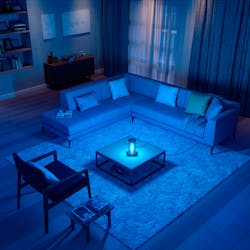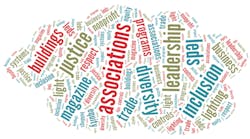Sales of UV-C lamps to OEM vendors and of high-pressure sodium (HPS) grow lights slowed the long running pace of decline in the “conventional” product sector in the third quarter at Signify, which today also revealed that it has begun selling a glass mercury-vapor UV-C residential tabletop lamp under its own label in Asia and the Middle East to help combat the novel coronavirus.
But third-quarter sales of products across all three Signify operating sectors — conventional, digital, and digital solutions — declined 8.3% in the pandemic economy on a comparable basis, as the commercial office and other businesses continue to look uncertain.
On a non-comparable basis, revenue for the quarter ending Sept. 30 rose 12.1% to €1.73 billion ($2.05B) from €1.54B ($1.83B) in the year earlier quarter when counting the acquisitions of US company Cooper Lighting Solutions and China's Zhejiang Klite Lighting Holdings Co., Ltd., neither of which Signify owned in the third quarter of 2019.
Net income rose 21% to €90 million ($106.73M) from €74M ($87.76M) in 2019's third quarter, as Signify continued cutting costs and also put considerable effort into holding prices steady. On an EBIT basis — income from operations and before taxes and other expenses — the increase was 14.9% from €114M ($135.19M) to €131M ($155.35M).
In a conference call with analysts this morning to discuss third-quarter results, CEO Eric Rondolat provided more detail than he had done previously on the company's ramp-up of lamps that emit UV-C radiation, which Signify has proven kills SARS-CoV-2, the virus that causes COVID-19.
Rondolat revealed that during the quarter, Signify began selling a UV-C tabletop lamp for the home market in China, Vietnam, Thailand, Singapore, Malaysia, Indonesia, Hong Kong, Philippines, and the UAE.
Rondolat said that Signify is looking into offering the lamp in other geographic territories. The company is believed to have encountered fewer regulatory obstacles in Asia and the UAE.
The exposed mercury vapor glass lamp emits ultraviolet radiation at 254 nm, and would thus be harmful to skin and eyes, as is characteristic of C-band UV. With a range of 100–280 nm, “C” is the shortest of the three ultraviolet bands.
The lamp's digital safety features include a voice control system, and a sensor that switches off operation when it detects motion indicating that people are present. Some observers would question whether those measures are adequate to ward off accidents.
Meanwhile, from a business perspective, Signify actually classifies the mercury vapor product as part of its “digital” lineup of products, which include LED bulbs and smart-home connected lighting products such as Hue and WiZ.
In fact, Signify is generally classifying the 12 new mercury vapor UV-C products it is developing under its own label within its digital classifications, a spokesperson explained to LEDs Magazine. They will tend to be part of systems that are digital, even if the light source itself is conventional, he noted. (CEO Rondolat reiterated today that LED-based UV-C is still a long way from any presence in Signify's product lineup).
But the company is also selling UV-C products to OEM vendors, and classifies those sales as “conventional,” the spokesperson said.
OEM customers are believed to include China's Goldensea, which is providing UV-C disinfection products to two 19thcentury Spanish theaters, although LEDs has been unable to confirm that.
The overall ramp-up of UV-C production appears to be going to plan.
“We are on track to multiply by 8 our capacity at the beginning of 2021,” Rondolat told analysts. “We are on allocation. We cannot sell all the orders we have at this point in time.”
Rondolat said Signify's UV-C ramp-up has included expanding capacity at a site in China, and refurbishing an oven it uses to make glass at its industrial site in Poland. It is in the process of adding another oven to that site, which it expects to complete by the end of the year.
“At this point in time, we've done nearly between half and two thirds of the capacity increase that we want to do, and we confirm that we're going to finalize according to plan by the end of the year,” Rondolat said.
Under its own brand, Rondolat also revealed that Signify won a deal in the third quarter to install ceiling-based UV-C air purifiers for the RB Leipzig soccer team in Germany, in dressing rooms and other areas. The ceiling-mounted units point UV-C radiation upwards in order to disinfect air circulating between the fixtures and the ceiling. The purifiers are part of a broader deal in which Signify will also install Li-Fi for press room Internet, and connected lighting for both inside and outside the stadium.
Back on the OEM side, UV-C sales to date supported what Rondolat described as a good performance for “conventional” products.
“We showed in the conventional part of the business less of a decline than the previous quarters, at minus 11%,” Rondolat said. The decline had been 25.6% in the second quarter, in the early days of Signify's new UV-C push, when UV-C had a smaller mitigating effect on the numbers.
In the third quarter a year ago, the conventional sector — then called “lamps” prior to a restructuring — declined 24.2% as EBIT (income from operations) dropped 52.4%. By comparison, in this year's third quarter, the EBIT decline in conventional was only 13.7%, to €35M ($41.5M) from €41M ($48.62M) a year ago.
Rondolat also credited the improvement in the conventional sector to the sale of HPS lights in the horticultural lighting market, where Signify sells both HPS and LED.
While UV-C and horticultural lighting sales are lively, the continued uncertainty of the global economy amid the pandemic held sales in check both in digital solutions and digital products — especially digital solutions, where comparable sales fell 11.2% in the third quarter. Counting Cooper and Klite, sales rose 31.2%, to €916M ($1.09B) from €698M ($827.68M) a year earlier.
One of the aims of digital solutions is to collect and analyze data gathered by sensors for customers, but Rondolat acknowledged that “not many customers are going for it at this point time.”
Sales of digital products fell 2% on a comparable basis and grew 1.9% on a nominal basis, to €575M ($681.85M) from €565M ($670M). EBIT jumped 111.3%, to €71M ($84.2M) from €33M ($39.13M). Rondolat said he was pleased the performance not only of Hue, which uses Zigbee and Bluetooth technologies, but also of WiZ, the Wi-Fi-oriented smart lighting company that Signify agreed to acquire in April 2019. He said WiZ is growing “slightly more” than planned. Signify recently positioned WiZ for broader mass-market appeal than Hue, its more time-honored brand.
Signify continued to withhold corporate financial guidance. Rondolat pointed to ongoing economic volatility.
MARK HALPER is a contributing editor for LEDs Magazine, and an energy, technology, and business journalist ([email protected]m).
For up-to-the-minute LED and SSL updates, why not follow us on Twitter? You’ll find curated content and commentary, as well as information on industry events, webcasts, and surveys on our LinkedIn Company Page and our Facebook page.





